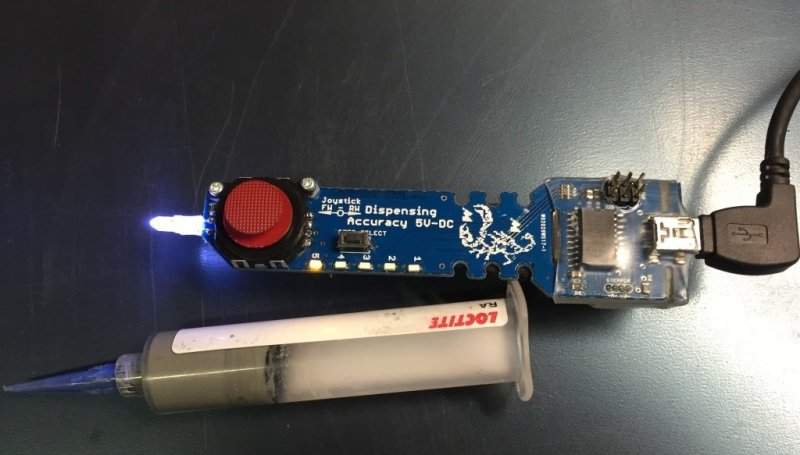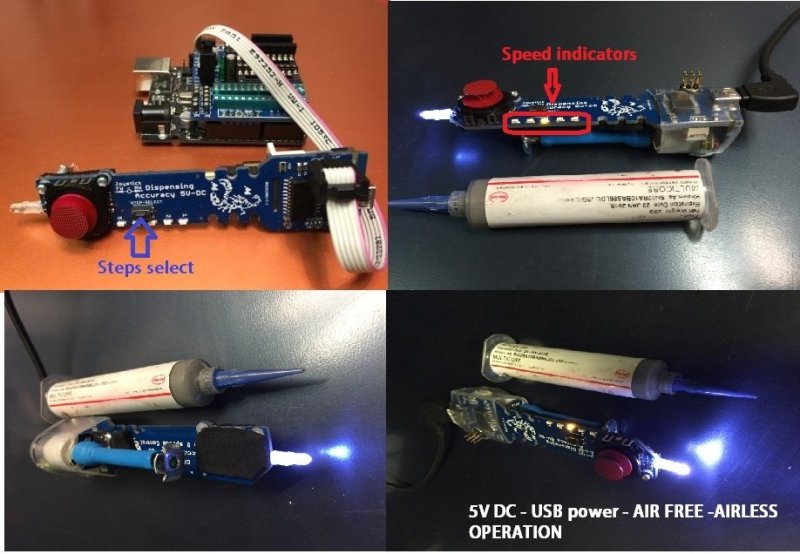If you’ve never used a solder paste dispenser, you’re missing out. Think about always using a crappy soldering iron, and then for the first time using a high-end one. Suddenly you’re actually not bad at soldering things! It’s kind of like that.
Most solder paste dispensers make use of compressed air, which requires an extra setup to use that you might not have. The goal of this project was to make a solder paste dispenser that doesn’t use compressed air, and doesn’t have any 3D printed parts (in case you don’t have a 3D printer) — and it looks like the inventor, [MikeM], succeeded!
It’s a pretty simple device, built on a PCB. You can select the steps taken, and control the output using a little joystick. A home-made linear actuator (threaded rod and nut) allow you to dispense any syringe-based solder paste, glue, or epoxy with great accuracy.
Here are some photos to give you a better idea of how the PCB works with the syringe. You can check out [MikeM’s] blog for more photos.
And of course, a quick demonstration:
It’s very similar to this other design we shared a few years back. Wonder which one works better?

















This is quite hack-a-licious. Nice to see something that doesnt involve a 3D printer, arduino, ESP or RPi.
^Not that there is anything wrong with using those dev tools. Just nice to see something different
On title page there is an old version of dispenser model 2015,
New model you can find here – this link – 2016 Model – Video might answer many of questions:
https://www.youtube.com/watch?v=ucoj6OZu5kI
Tindie Sell anyone, i would buy one
https://www.tindie.com/products/marjan_mike/solder-paste-dispenser-v3-/?pt=full_prod_search
Yes – you can buy there- back in stock.
looks more like an ad for a product for sale – i couldnt find any details about the project even tho ive found a way to buy one in less than 30 seconds.
it is an ad. hex-file on his blog http://wordpress.mencinger.biz but nothing else, no schematics, … the hackaday.io-entry should be deleted and this article too!
Damn straight.
On the photos there is arduino-alike board but he didn’t even mentioned type of micro he used.
http://i.imgur.com/olB0hX5.gif
Where do on finds these small electric linear actuators so cheap?
Looks like a far better way than compressed air.
The three things about compressed air are having the compressor, the tubing/controller, and the liquid part of the solder paste can separate out in the nozzle. That last part looks like it might still be a problem.
I haven’t used a stencil, but they’re looking more appropriate for some things. You can get a small one for like $20-40. That might seem like a bunch for a little piece of metal but think of the time you’re saving on each pad on your board. It makes sense when you have lots of little pads, even for a one-off prototype.
This still looks nice for the small boards. I just wish the nozzle weren’t a long thin thing, they’re always annoying to clean out.
One of the big problems with mechanical plungers is ooze. If any of the parts of the syringe, plunger, needle, or paste itself are the slightest bit compressible, they act like springs and keep pushing out paste after you’ve let go of the button. With compressed air, the syringe is completely depressurized as soon as the switch is released, mitigating a lot of the ooze. Many dispensers can also pull a slight vacuum on the syringe when not dispensing, which helps even more.
With a good compressed air dispenser, the amount of paste dispensed per actuation can be set very precisely, and if the tip is sized correctly for the pads, cycle times can be very short, allowing paste to be precisely placed at a rate greater than one pad/second.
For hobby use, motorized plungers like this one do help reduce hand fatigue from operating a manual plunger, and depending on one’s motor skills might improve consistency. But I’ve yet to see someone come anywhere close to the speeds that are achievable with compressed air. The slow-to-start, slow-to-stop nature of the motorized approach requires a lot of dabbing/dwelling. Are projects like this worthwhile for their cost? Sure. Better than compressed air? I’m not convinced.
I had to evaluate a few dispensers about 20 years ago that were going to be used to apply a paste to aircraft engine parts prior to vacuum brazing and found performance varied with compress air units. An operator using these every day, eight hours a day will develop skills with just about any system, but for occasional use I would not select a compressed air device based on my experience. Again it was a long time ago and things change.
The vacuum part is important. I built a compressed air driven dispenser that used accurately timed air pulses with regulated pressure. It worked ok, but would build up a blob of paste on the end of the dispense needle as you work. The commercial unit that I use at work (OKI / Metcal) have the vacuum suckback and don’t have this problem at all. So much for my home made “Droolomatic”. I looked at adding suckback to my home made unit and decided that it would be easier and faster to buy one,
I’m using a ghetto DIY machine at home that’s all made from old spare parts. Compressed air + spare valve I had + quick connects, and a very ghetto 555 & pot (as a one shot) to control the timing (drives a mosfet which powers the coil), triggered by a foot pedal. It doesn’t have vacuum, but the dispensing hose gets exhausted after the pulse. It works about as good as our OKI machine really, but then again it depends on your paste, needle size, etc.
Your description sounds almost exactly like mine, a footpedal triggering a 555 timer as a one-shot, driving an NFET driving a 3 way solenoid valve. The dispenser is on the “common” valve fitting, the regulated air source is on the “energized” valve fitting and the “off” fitting is open to atmosphere. I did not mess with the needle size any, but the same needle and paste works fine on my OKI machine (I bought one rather than mess with the droolomatic farther).
Over the years, I have found that if I spend months perfecting a tool to do a job, the original job gets lost. Since my goal at that time was to build a GPS Cape for a Beaglebone, perfecting the solder dispenser was a distraction. It may be a rationalization for buying some expensive tools, but a lot more of my projects get finished when I stay focused on the project rather than the tools. I’m not preaching or chastising here, just passing on something that helped me get my projects completed more often!
Yes. mine is *exactly* like that.
if I spend months perfecting a tool to do a job, the original job gets lost
Yes, very much so. It’s far too easy to spend a lot of time on “side quests”, building equipment for everything, writing software for a lot of small things, starting on related side projects before finishing this one and what not…
Should not be that hard to let the motor do a forward/reverse cycle so it only pushes just enough paste out for one pad, or does that not really work because the plunger is not attached to the gasket in the syringe? If so, you probably could make a disposable plunger that you glue in the syringe.
Build in Stepper Motor has a reverse movement in V3 of dispenser – for all speeds.
Too bad there isn’t any real build details in the article or on the project site. Like “Chris” said, looks like an ad, not a project.
No lipo? That would make it even more flexible compared to the compressed air ones. But i guess a usb cable is very portable and the use cases are kind of limited..
And if it did use a LiPo, and had pullback, we’d have LiPoSuction!
$46.00 with Shipping to United States starts at $12.00 seems a bit steep for a what looks like a fragile prototype.
Up to date all arrived woking to US and Canada.
No worries – see replies in feedback of guests!
Oh, no! One of those articles that present a fragile prototype aimed to create the buzz to sell an overpriced underthought product. Why is this article here? There is no schematic, no BOM, no code, no nothing. Thanks Hackaday, getting better with each day.
There are at least two projects out there, open source, that did not make it here, although they should have:
https://www.thingiverse.com/thing:1119914
http://letsmakerobots.com/content/solder-paste-dispenser
I cheat anyhow: I unscrew the needle and squeeze a tad out.
Hello –
I have logged into his webpage few days ago and I am surprised by some comments, I thought that this is about:
– Our front page is a mix of hacks from around the community as well as our own original content. We strive to promote the free and open exchange of ideas and information. We educate those just learning the art of Hack, and provide inspiration for the seasoned veterans. Don’t be shy; if you want to show off your project, or have found something cool of someone else’s that deserves sharing, send us a link!
– But don’t just read Hackaday — you should delve deeper into the community. Document your work on our hosting site at Hackaday.io. Tell the world about your interests and show off the stuff you’ve already built. Start a build log for that project you’ve been dreaming of recently. Make some friends and collaborate with them on a project. Get lost digging through mountains of gnarly hacks.
Thanks – You may remove all my membership & articles if they do not meet your requirements.
Mike
I have the V2 of this, and can confirm that the oozing definitely happens, but it’s pretty slow and steady; you quickly learn to work with it and I’ve even become proficient after a couple of boards to know exactly the pacing needed and when to/not to push the dispense button. A board with 40 RCL pads and another 40 uC pins only takes about 4 minutes of pasting.
Thanks for your kind feedback -I appreciate it very much!
Mike
Hello,
V3 has no oozing due too auto reverse movement of the piston ….